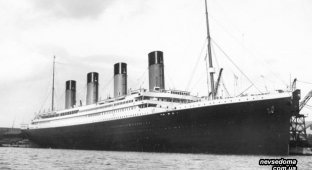On April 10, 1912, the Titanic liner set off from the port of Southampton on its first and last voyage, but 4 days later it collided with an iceberg. We know about the tragedy that claimed the lives of almost 1,496 people largely thanks to the film, but let's get acquainted with the real stories of the Titanic passengers.
The real cream of society gathered on the passenger deck of the Titanic: millionaires, actors and writers. Not everyone could afford to buy a first class ticket - the price was $60,000 at current prices.

3rd class passengers bought tickets for only $35 ($650 today), so they were not allowed to go above the third deck. On the fateful night, the division into classes turned out to be more noticeable than ever...

One of the first to jump into the lifeboat was Bruce Ismay, the general director of the White Star Line, which owned the Titanic. The boat, designed for 40 people, set sail with only twelve.

After the disaster, Ismay was accused of boarding a rescue boat, bypassing women and children, and also of instructing the captain of the Titanic to increase speed, which led to the tragedy. The court acquitted him.

William Ernest Carter boarded the Titanic at Southampton with his wife Lucy and two children Lucy and William, as well as two dogs.

On the night of the disaster, he was at a party in the restaurant of a first-class ship, and after the collision, he and his comrades went out onto the deck, where the boats were already being prepared. William first put his daughter on boat No. 4, but when it was his son's turn, problems awaited them.

13-year-old John Rison boarded the boat directly in front of them, after which the officer in charge of boarding ordered that no teenage boys be taken on board. Lucy Carter resourcefully threw her hat on her 11-year-old son and sat down with him.

When the landing process was completed and the boat began to descend into the water, Carter himself quickly boarded it along with another passenger. It was he who turned out to be the already mentioned Bruce Ismay.

21-year-old Roberta Maoney worked as a maid to the Countess and sailed on the Titanic with her mistress in first class.

On board she met a brave young steward from the ship's crew, and soon the young people fell in love with each other. When the Titanic began to sink, the steward rushed to Roberta's cabin, took her to the boat deck and put her on the boat, giving her his life jacket.

He himself died, like many other crew members, and Roberta was picked up by the ship Carpathia, on which she sailed to New York. Only there, in her coat pocket, did she find a badge with a star, which at the moment of parting the steward put in her pocket as a souvenir of himself.

Emily Richards was sailing with her two young sons, mother, brother and sister to her husband. At the time of the disaster, the woman was sleeping in the cabin with her children. They were awakened by the screams of their mother, who ran into the cabin after the collision.

The Richards were miraculously able to climb into the descending lifeboat No. 4 through the window. When the Titanic completely sank, the passengers of her boat managed to pull seven more people out of the icy water, two of whom, unfortunately, soon died of frostbite.

The famous American businessman Isidor Strauss and his wife Ida traveled in first class. The Strauss had been married for 40 years and had never been separated.

When the ship's officer invited the family to board the boat, Isidore refused, deciding to give way to women and children, but Ida also followed him

Instead of themselves, the Strauss put their maid in the boat. Isidore's body was identified by a wedding ring; Ida's body was not found.

The Titanic featured two orchestras: a quintet led by 33-year-old British violinist Wallace Hartley and an additional trio of musicians hired to give the Caf? Parisien with a continental touch.

Usually, two members of the Titanic orchestra worked in different parts of the liner and at different times, but on the night of the ship's sinking, all of them united into one orchestra.

One of the rescued passengers of the Titanic would later write: “Many heroic deeds were performed that night, but none of them could compare with the feat of these few musicians, who played hour after hour, although the ship sank deeper and deeper and the sea got closer. to the place where they stood. The music they performed entitled them to be included in the list of heroes of eternal glory."

Hartley's body was found two weeks after the sinking of the Titanic and sent to England. A violin was tied to his chest - a gift from the bride. There were no survivors among the other orchestra members...

Four-year-old Michel and two-year-old Edmond traveled with their father, who died in the sinking, and were considered "orphans of the Titanic" until their mother was found in France.

Michel died in 2001, the last male survivor of the Titanic.

Winnie Coates was heading to New York with her two children. On the night of the disaster, she woke up from a strange noise, but decided to wait for orders from the crew. Her patience ran out, she rushed for a long time along the endless corridors of the ship, getting lost.

She was suddenly directed by a crew member towards the lifeboats. She ran into a broken closed gate, but it was at that moment that another officer appeared, who saved Winnie and her children by giving them his life jacket.

As a result, Vinny ended up on the deck, where she was boarding boat No. 2, which, literally by miracle, she managed to board..

Seven-year-old Eve Hart escaped the sinking Titanic with her mother, but her father died during the crash.

Helen Walker believes that she was conceived on the Titanic before it hit an iceberg. “This means a lot to me,” she admitted in an interview.

Her parents were 39-year-old Samuel Morley, the owner of a jewelry store in England, and 19-year-old Kate Phillips, one of his workers, who fled to America from the man's first wife, seeking to start a new life.

Kate got into the lifeboat, Samuel jumped into the water after her, but did not know how to swim and drowned. “Mom spent 8 hours in the lifeboat,” said Helen. “She was in only a nightgown, but one of the sailors gave her his jumper.”

Violet Constance Jessop. Until the last moment, the stewardess did not want to be hired on the Titanic, but her friends convinced her because they believed that it would be a “wonderful experience.”

Before this, on October 20, 1910, Violette became a stewardess of the transatlantic liner Olympic, which a year later collided with a cruiser due to unsuccessful maneuvering, but the girl managed to escape.

And Violet escaped from the Titanic on a lifeboat. During the First World War, the girl went to work as a nurse, and in 1916 she got on board the Britannic, which... also sank! Two boats with a crew were pulled under the propeller of a sinking ship. 21 people died.

Among them could have been Violet, who was sailing in one of the broken boats, but again luck was on her side: she managed to jump out of the boat and survived.

Fireman Arthur John Priest also survived a shipwreck not only on the Titanic, but also on the Olympic and Britannic (by the way, all three ships were the brainchild of the same company). Priest has 5 shipwrecks to his name.

On April 21, 1912, the New York Times published the story of Edward and Ethel Bean, who sailed in second class on the Titanic. After the crash, Edward helped his wife into the boat. But when the boat had already sailed, he saw that it was half empty and rushed into the water. Ethel pulled her husband into the boat.

Among the Titanic's passengers were the famous tennis player Carl Behr and his lover Helen Newsom. After the disaster, the athlete ran into the cabin and took the women to the boat deck.

The lovers were ready to say goodbye forever when the head of the White Star Line, Bruce Ismay, personally offered Behr a place on the boat. A year later, Carl and Helen got married and later became the parents of three children.

Edward John Smith - captain of the Titanic, who was very popular among both crew members and passengers. At 2.13 a.m., just 10 minutes before the ship's final dive, Smith returned to the captain's bridge, where he decided to meet his death.

Second Mate Charles Herbert Lightoller was one of the last to jump from the ship, miraculously avoiding being sucked into the ventilation shaft. He swam to collapsible boat B, which was floating upside down: the Titanic's pipe, which came off and fell into the sea next to him, drove the boat further from the sinking ship and allowed it to remain afloat.

American businessman Benjamin Guggenheim helped women and children into lifeboats during the crash. When asked to save himself, he replied: “We are dressed in our best clothes and are ready to die like gentlemen.”

Benjamin died at the age of 46, his body was never found.

Thomas Andrews - first class passenger, Irish businessman and shipbuilder, was the designer of the Titanic...

During the evacuation, Thomas helped passengers board lifeboats. He was last seen in the first class smoking room near the fireplace, where he was looking at a painting of Port Plymouth. His body was never found after the crash.

John Jacob and Madeleine Astor, a millionaire science fiction writer, and his young wife traveled first class. Madeleine escaped on lifeboat No. 4. John Jacob's body was recovered from the depths of the ocean 22 days after his death.

Colonel Archibald Gracie IV is an American writer and amateur historian who survived the sinking of the Titanic. Returning to New York, Gracie immediately began writing a book about his voyage.

It is she who has become a real encyclopedia for historians and researchers of the disaster, thanks to the large number of names it contains of stowaways and 1st class passengers remaining on the Titanic. Gracie's health was severely compromised by hypothermia and injuries, and he died at the end of 1912.

Margaret (Molly) Brown is an American socialite, philanthropist and activist. Survived. When panic arose on the Titanic, Molly put people into lifeboats, but she herself refused to board them.

“If the worst happens, I’ll swim out,” she said, until eventually someone forced her into lifeboat number 6, which made her famous.

After Molly organized the Titanic Survivors Fund.

Millvina Dean was the last surviving passenger of the Titanic: she died on May 31, 2009, aged 97, in a nursing home in Ashurst, Hampshire, on the 98th anniversary of the liner's launch. .

Her ashes were scattered on October 24, 2009 at the port of Southampton, where the Titanic began its first and last voyage. At the time of the death of the liner she was two and a half months old























